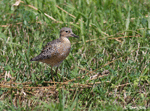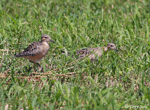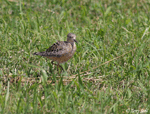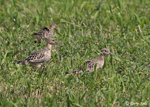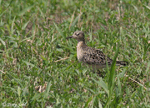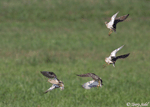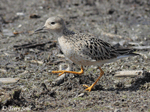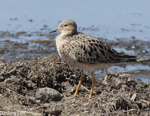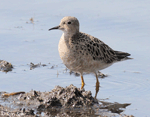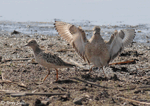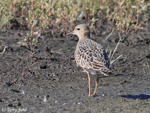| Length: 8 inches | Wingspan: 16 inches | Seasonality: Migrant |
| ID Keys: Habitat is good clue. Also note buff face, head, and underparts, dark "scaly" looking back, yellow legs, round head, short bill. | ||
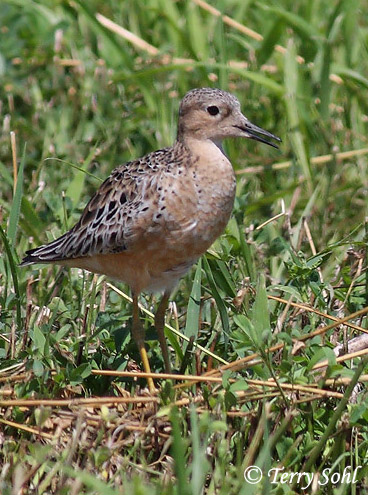 The
Buff-breasted Sandpiper prefers the dry open ground of prairies and open
agricultural fields rather than the shorelines and mudflats that many
sandpipers prefer. In many ways, they are more similar in appearance
to plovers than they are to other sandpipers. They were once abundant
migrants through the state, but hunting in the 1800s and early 1900s
severely depleted their numbers, and they've never fully recovered. They are
still currently considered a "near-threatened" species globally.
The
Buff-breasted Sandpiper prefers the dry open ground of prairies and open
agricultural fields rather than the shorelines and mudflats that many
sandpipers prefer. In many ways, they are more similar in appearance
to plovers than they are to other sandpipers. They were once abundant
migrants through the state, but hunting in the 1800s and early 1900s
severely depleted their numbers, and they've never fully recovered. They are
still currently considered a "near-threatened" species globally.
Habitat:
Breeds on slopes of the Arctic Tundra, preferably near open water. During migration, they are most often found on dry open areas, such as plowed fields, short-grass prairie, and grazed pasture. Mowed alfalfa fields are often used as well.
Diet:
Primary food item is insects and spiders in all seasons. They will also occasionally feed on seeds and small crustaceans.
Behavior:
Feeds while walking, usually with quick walking or running with intermittent pauses as it searches for insects.
Breeding:
Non-breeder in South Dakota. On their breeding grounds on tundra line north of the Arctic Circle, Buff-breasted Sandpiper females separate from the males after mating, selecting and building a nest site on their own. The nest is a shallow scrape on the ground, typically placed next to a clump of vegetation, and lined with mosses, sedge, and leaves. The female lays between 2 and 6 eggs and she alone incubates them. The young hatch after about 19 days, with another 18-20 days before they fledge from the nest.
Song:
Soft p-r-r-reek, but rarely during migration through the state. Males also sometimes make a fast clucking sound on its summer breeding grounds.
1Click here to hear the call of a Buff-breasted Sandpiper
Migration:
Summers on the Arctic Tundra. Winters on the pampas of Argentina.
Interactive eBird Map:
Click here to access an interactive eBird map of Buff-breasted Sandpiper sightings
Similar Species:
Buff-breasted Sandpipers do have a rather unique plumage and look if seen well, but could potentially be confused with the following:
- Upland Sandpiper - Upland Sandpipers are a "shorebird" that are found in grassland habitats even more than Buff-breasted Sandpipers. Both may share the same habitat at times during migration in South Dakota, and share some plumage similarities. Upland Sandpipers, however, are taller and have a longer neck than Buff-breasted Sandpipers. They also have a noticeably longer bill. Upland Sandpipers also have the habit of using fence posts as perches, while Buff-breasted Sandpipers are nearly always on the ground.
- Pectoral Sandpiper - Pectoral Sandpipers are normally found along shorelines and in shallow water, while Buff-breasted Sandpipers rarely are. They are about the same size and structure, with a similar looking back. However, Pectoral Sandpipers have a sharp demarcation between a white belly and a streaked breast, while Buff-breasted Sandpipers are more uniformly (buffy) colored below. Pectoral Sandpipers also have a longer bill, usually with some yellow at the base, and a slight droop.
Conservation Status:
While once abundant, they are now quite uncommon. Hunters killed a great many of these birds during the 1800s and early 1900s. In addition, habitat destruction has taken a toll, especially on their migration routes and wintering grounds. Recent surveys show there have been additional declines in recent decades. As a result, the IUCN considers the Buff-breasted Sandpiper as a "Near Threatened" species.
Further Information:
1) BirdWeb - Buff-breasted Sandpiper
2) WhatBird - Buff-breasted Sandpiper
3) Audubon Guide - Buff-breasted Sandpiper
Photo Information:
August 1st, 2008 - Kingsbury County, South Dakota - Terry Sohl
Additional Photos:
Click on the image chips or text links below for additional, higher-resolution Buff-breasted Sandpiper photos.
Audio File Credits:
1Bernabe Lopez-Lanus. Recorded in Uruguay on February 24th, 2005. Original recording and information from xeno-canto.
| Click on the map below for a higher-resolution view |
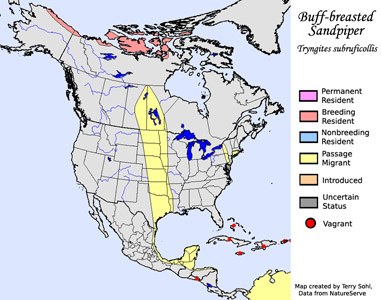 |
| South Dakota Status: Rare migrant, primarily in the eastern part of the state. |
Additional Buff-breasted Sandpiper Photos
Click for a higher-resolution version of these photos
